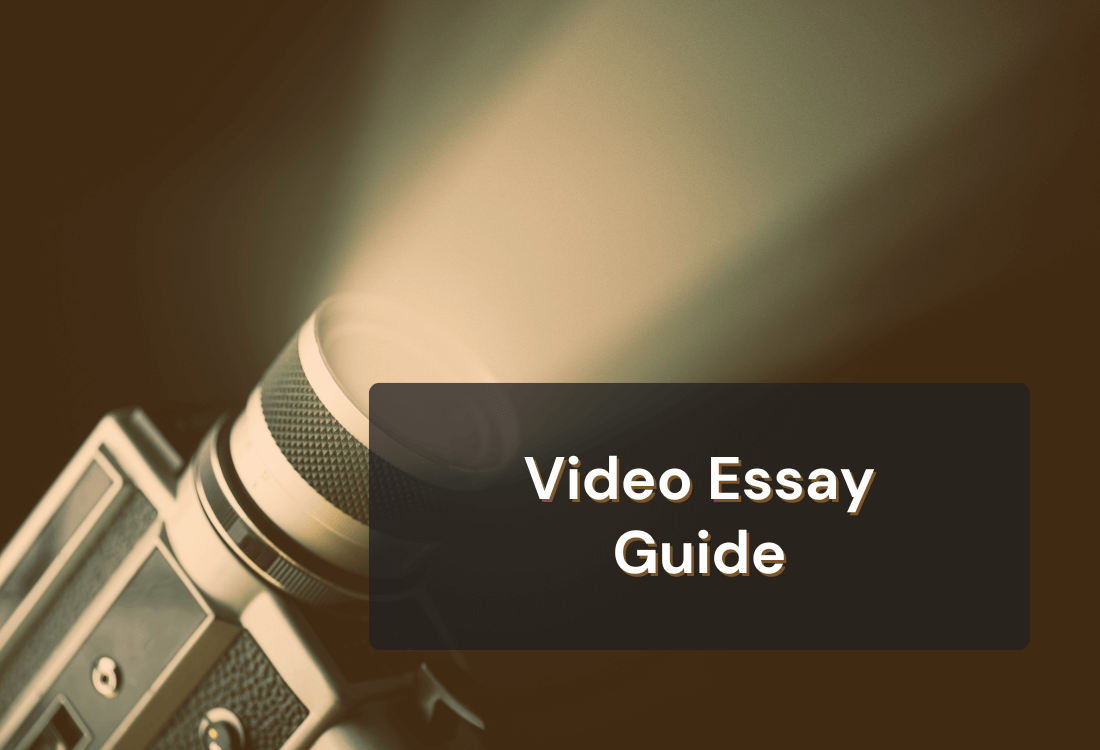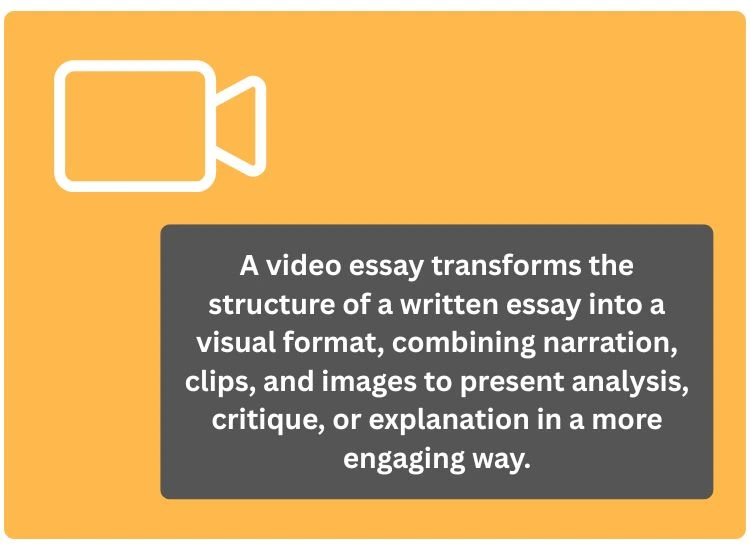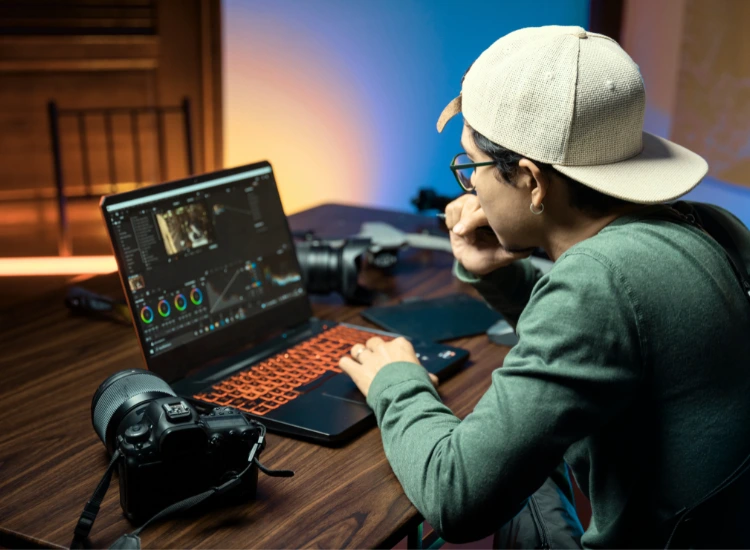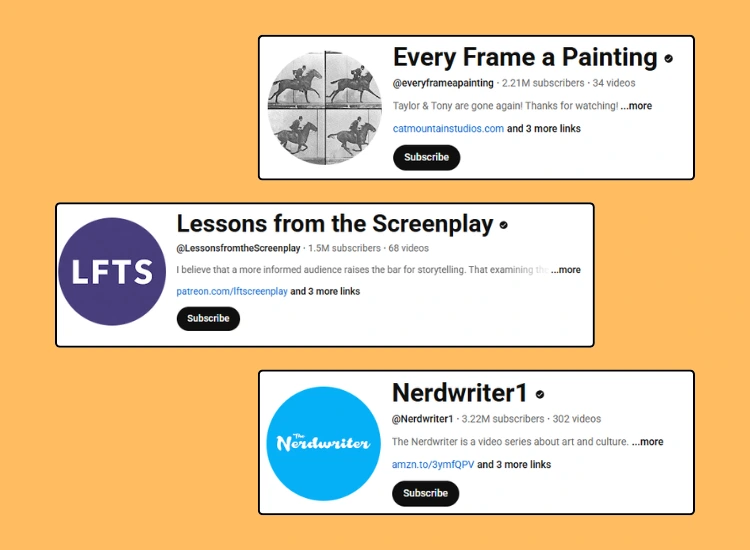



What does it mean to make a video essay? A video essay is a type of digital storytelling that uses spoken narration, pictures, and analysis to make a clear point or look at a subject. This format is different from a regular written essay because it uses sound, moving visuals, video clips, and graphics to make the experience more interesting and complex for viewers.
Video essays have gained popularity recently among teachers, filmmakers, and internet content creators. They are used to explain difficult ideas, criticize the media, and show new points of view in ways that are easy to understand and look good. In this article, we will discuss what makes a video essay unique, its origins, and how to construct one that is effective.

A video essay is best thought of as an argument or remark that uses more than one medium. It takes the shape of a written essay and changes it to fit a visual platform. You see clips from movies, pictures, animations, or graphics instead of text. Instead of reading words on a page, you hear them as a voiceover. This mix of sound and pictures lets the designer share a point of view in a way that feels real and interesting.
The main difference between a video essay and a regular film or documentary is that a video essay is more analytical. Its goal is more than just amusement; it can also be used for interpretation, criticism, or explanation. For instance, a film student might make a video essay about how a director uses color, and a historian might use the same format to show how newsreels changed people's minds in the past. The basic framework stays the same no matter what the topic is: a major argument backed up by pictures, narrative, and editing that all work together to make the point.
Common characteristics of video essays include:
This structure is quite flexible, which is why it works well in schools, online, and in the workplace.

The concept of the video essay first took hold in academic and film studies circles. Scholars recognized that utilizing the medium itself for analysis was more effective than simply describing it in writing. By showing clips while offering commentary, students and researchers could highlight subtle techniques like camera angles, sound design, or editing choices in real time.
As online video platforms grew, the video essay quickly expanded beyond academia. Sites like YouTube and Vimeo gave independent creators the tools and distribution channels to share their analyses with global audiences. One study from Statista found that educational and commentary videos rank among the top five most-watched content categories on YouTube, reflecting the demand for this type of media-driven insight.
Video essays are now a common way to make digital material. Millions of people have watched videos by creators like Every Frame a Painting and Nerdwriter because they combine precise analysis with interesting visuals. At the same time, teachers and colleges use them to help students learn difficult concepts. This change has made the video essay both a creative art form and a useful way to talk to people.
Video essays are becoming an important way to learn, communicate stories, and talk to people at work. They are powerful because they mix analysis with visual narrative, which makes ideas easier to understand and more fun to watch.
Educators use video essays to help students grasp complex topics. By layering narration with images, diagrams, or film clips, learners can see how concepts play out in real time. Universities and schools now encourage students to submit video essays as alternatives to traditional papers, giving them the chance to demonstrate both subject knowledge and digital literacy.
For content creators, video essays offer a way to connect with audiences on a deeper level. Instead of producing purely entertainment-driven videos, creators can use video essays to share insights, critiques, and new perspectives. This is why platforms like YouTube are filled with essays about films, culture, and social issues that attract millions of viewers.
Video essays have also been found to be useful for companies and brands. Companies use them to show off their thought leadership, interestingly explain complicated products, or point out trends in their field. Journalists and advocacy groups utilize this approach to get people to care about important issues by combining facts with a strong story to get people to act.
Video essays work in any situation because they combine analysis with storytelling, which makes information both memorable and convincing.

While video essays come in many styles, most share a few core elements that shape their impact:
For further guidance and insights to help your video essays feel polished, confident, and impactful, refer to these college video essay tips.
Here’s a simple roadmap for creating a video essay:
A video essay works best when it has a clear focus. Decide on a subject that interests you and shape a thesis statement around it. For example, you could explore how a director uses lighting to create mood or how advertising influences consumer behavior. Narrowing your scope ensures your essay stays concise and impactful.
A strong video essay is built on research. Use credible sources like books, articles, and academic journals to support your argument. Once you’ve gathered your material, write a script that combines analysis with storytelling. Aim for a conversational tone that feels natural when spoken aloud.
Collect supporting visuals such as film clips, photographs, or charts. Make sure you have permission to use these materials. Many creators rely on public domain footage, stock video, or their own original recordings. These assets provide the visual foundation for your analysis.
Your narration carries the essay. Record in a quiet space and speak clearly at a steady pace. Teleprompter.com app can help you maintain flow and avoid unnecessary pauses. This ensures your delivery matches the professional quality of your content.
Editing ties everything together. Align your narration with visuals, add transitions, and incorporate music or sound effects to improve the mood. Keep pacing in mind: if it’s too slow, you risk losing your audience. If it’s too fast, your argument may feel rushed. Finally, review your essay and make adjustments until the flow feels polished.

Video essays have become a cultural staple, with certain creators and works standing out as benchmarks of the format.
These examples illustrate the diversity of video essays. Some focus on technical film analysis, others on cultural commentary, but all share the ability to engage audiences through the interplay of visuals and narration.
Understanding what is a video essay means recognizing its unique ability to combine narration, visuals, and editing into a powerful storytelling format. From academic projects to YouTube critiques and professional presentations, this medium continues to grow as a valuable way to inform, persuade, and inspire.
For students, it offers a modern approach to learning and expression. For creators, it’s a chance to connect with audiences on a deeper level. And for professionals, it serves as a polished tool for communicating complex ideas with clarity and impact.
If you’re ready to create your own video essay, start with a solid script, strong visuals, and smooth delivery. Sign up with Teleprompter.com for a tool that will help you maintain clear and assured narration.
A video essay blends narration, visuals, and sound. It uses clips, images, and graphics to present an argument or analysis in a visual storytelling format.
Start with a strong idea, write a script, gather visuals, record your narration, and edit everything together using a clear structure and smooth pacing.
A written essay relies on text to explain ideas, while a video essay combines spoken words, visuals, and editing to communicate through sight and sound.
The purpose is to analyze, interpret, or explain a topic using both visuals and narration to make the message more engaging and easier to understand.
Most video essays last between 5 and 15 minutes, long enough to explore an idea in depth while keeping viewers’ attention from start to finish.



